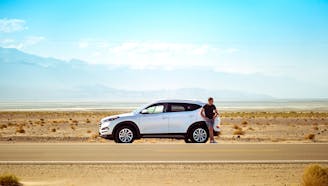
Auto Insurance
A Crash Course

You just bought a new car. You test drove a lot of cars, examining every detail like a nuclear physicist. Would this car make you look cool? Does the cupholder sit just so? Does the rev of the engine make you want to exclaim “Vroom, vroom! It’s driving time, baby!”? You finally settle on one that fits your needs. But before you can flaunt your new ride, you’ve got to get it insured. At Branch, we want to make sure you feel safe and secure in knowing how auto insurance works.
1. What is auto insurance?
The Insurance Information Institute puts it best: Automotive insurance is an agreement between you and your insurance provider to protect you against financial loss to the limits set in the policy in the event of a variety of circumstances. Auto liability coverage is required by all states in varying forms and the main components of it work to protect your finances in the most common situations – because the last thing you need when you’ve been in an accident is wallet whiplash.
2. What’s in auto insurance?
Auto insurance contains 3 main components that cover specific protections and circumstances and can vary by both state and insurance provider. Each component is sort of like a cake full of mini cakes. Who knew car insurance could be so delicious!?
Here’s a brief list of what’s in auto insurance, with more detailed explanations below:
- Liability
- Uninsured/Underinsured motorist
- Personal injury protection
undefined - Physical damage
Liability insurance has two layers: BI/PD, which is insurance shorthand for bodily injury and property damage. Both are for if your vehicle injures someone else or damages someone else's property. This is a super important coverage to have in your auto insurance policy because it protects you when you've been found at fault for an accident, so be sure to read any auto insurance’s liability coverage plan closely.
Uninsured/underinsured motorist (UM/UIM) coverage is pretty straightforward. If you’re in a collision with a motorist who has no insurance or their insurance is lacking, UM/UIM has your back. Worth noting that liability and UM/UIM are separate because UM/UIM provides you assistance where you’re not at fault, while liability provides other people assistance in situations where you’re at fault.
Personal injury protection (PIP) is like a warm apple pie on a chilly day, cozy and comforting through and through. PIP won’t prevent you from being injured, but it does help cover medical costs associated with a collision. Part of PIP includes medical coverage, which covers the financial burden of treating your injuries, rehabilitation, and sometimes lost wages and funeral costs. PIP isn’t available in every state, so be sure to ask your insurance provider about it and what options you can take if you live in a state without PIP.
Physical damage coverage has two main components that work in tandem to cover the broadest array of damages that could happen to your vehicle: Collision and comprehensive.
Collision is for damages your car had an active role in, like banging your door into a streetlamp that you thought you parked further away from or backing over a shopping cart you forgot to return to the cart corral. These are likely covered under the collision. Sadly there’s no coverage for the embarrassment of steamrolling a shopping cart or bonking your door into a street pole, but at least you have peace of mind knowing that your vehicle can be repaired – even if it leaves your ego a little bruised explaining to the auto repair shop what happened.
Comprehensive coverage is for when your car receives damages while it was just hanging out minding its own business. Let’s say you park your car on the street outside your home and while parked there, it got scratched and dented by a roving gang of feral hogs. That’d be covered under comprehensive! If a massive hail storm smashes your car windows and then a tree falls on the roof and then someone breaks into your car and steals the radio, that’s a pretty terrible sequence of events to have to deal with. But comprehensive coverage is there for you so you won’t feel like the whole world has it out for your innocent car.
A few important notes
Liability insurance is required in some form in every state, whether through an insurance provider or as a fee you pay directly to the state. UM/UIM, PIP, and Medical coverage are optional in most states.
There may be situations where multiple aspects of your insurance policy come into play.
For example: You parked your car in your driveway and thought to yourself, “It’s such a pleasant day. I think I’ll take a little nap with the windows down before I head inside.” While you’re asleep, your car rolls out of your driveway and into your neighbor’s yard. You don’t wake up until after your car crashes into your neighbor’s antique – and hideous! – garden gnome collection. As your car was on a mission to destroy some gnomes, it rolls over your neighbor’s foot. You wake up as your head slams against the steering wheel. This isn’t ideal – even if you hated those garden gnomes and are glad they’re gone – but if it happens, your auto insurance would likely cover the following issues:
- Your car’s bumper is banged up
- Your neighbor is limping in pain
- You smacked your head something awful
- Those ugly garden gnomes are broken beyond repair
In this instance, your insurance would provide:
- Repairs to your vehicle (physical damage)
- Replacement of the garden gnomes and yard repair (liability insurance)
- X-Rays of your neighbor’s foot (liability insurance)
- Your concussion treatment and rehab for whiplash (personal injury protection/medical payments)
3. Who’s covered in my auto insurance?
Alongside these three main components of auto insurance, who is covered and how your coverage is applied are important factors to consider when selecting an auto insurance policy. For the most part, auto insurance covers your vehicle(s) as well as you, your spouse, and any resident relative driving your car (with your permission). Usually, you’ll also be covered when driving someone else’s car (with their permission).
4. What are deductibles?
Essentially, a deductible is how much you’re comfortable paying out of pocket before your insurance provider covers expenses. A possible way of thinking about this is the less risk you have, the higher your deductible should be. This is because you’re anticipating you won’t need financial assistance from your insurance provider. For example, if you live by yourself in a town where the population is literally just you and there’s nothing that could crash into your vehicle or that you could crash into, you’d be better off with a higher deductible because the risk of damage, theft, or other situations that would necessitate using your auto insurance are extremely low.
But if you’re like most people and you live in society, where there are other cars and buildings and people, you may want a lower deductible. The trade-off between high and low deductibles is simple: a high deductible will result in a lower premium while a low deductible means a higher premium.
5. Why do I need auto insurance?
State law, most likely. According to The Balance, only two states don’t require auto insurance: Virginia and New Hampshire. In those states, there are other options, like bonds or paying the state directly. Without insurance, you’ll still be liable for damages or injuries and if you can’t afford to pay you’ll have your license and registration suspended. And it’s not cheap. In New Hampshire, you’ll be on the hook for up to $50,000 liability and $25,000 for property damage – out of your own pocket. In Virginia, the $500 you pay the state each year doesn’t serve as any sort of coverage – it just allows you to go without car insurance. If you find yourself in an accident, you’ll be fully liable and will have to pay out of pocket. You might save money just paying the state $500 a year instead of an insurance premium, but those savings don’t mean much when you’re paying thousands of dollars out of pocket with no insurer to help you out.
For Virginia and New Hampshire, you assume total financial responsibility for your vehicle and anything that happens to anyone else. The risks involved in that setup are extremely steep, but it’s worth noting that while Virginia and New Hampshire don’t require auto insurance, you’re able to – and absolutely should – get auto insurance in both states.
For the other 48 states, you’ll need insurance provided by an insurance company licensed with your state. If you’re leasing a vehicle, the leasing company will likely have insurance requirements as part of the lease agreement. You’ll have to get specific coverages or deductibles as outlined by the lease, but you’ll have the choice to get insured through a provider of your choice.
6. How do I choose what’s best for me?
Where you get your auto insurance, what coverages and limits you choose, and which deductible choices are right for you are all dependent on your personal needs, financial circumstances, and overall lifestyle. Getting insured is an ideal time to examine your life – your expectations for the future, how much you use your vehicle and in what kind of traffic, and how much peace of mind you want when it comes to your car. There’s no one-size-fits-all policy, just like there’s no one-size-fits-all person.
If you’ve had insurance and are switching coverage, it’s useful to examine the policy limits you selected at the time and whether those work for where you’re currently at. If you recently bought a new car, added a car, or have a teen driver, you’ll want to look into tinkering with your policy to make sure it fits your life. If you’re getting insured for the first time, it’s best to examine your finances and general risks in your life, like how long your commute is and how busy it is, what type of weather you drive through, and how much you can afford to pay out of pocket in the event of an emergency. Overall, you should consider how much peace of mind you’d like – you’d be surprised how much a weight off your shoulders it is when you’re in the middle of a crisis and you know someone’s got your back through it. At Branch, we’re all about getting your back.
Hopefully this breakdown has been illuminating and resolved some of your major questions about choosing auto insurance. If you still have questions, feel free to contact us at 833-4BRANCH or head over to Branch to get covered in minutes.
With love,
Branch
Want a price?
Get a price within minutes with just your basic informationTo provide your accurate price, we'll ask you for information as well as gather information such as your claims, driving, and credit information, including credit report, from other sources for you and your household. Texas only: seeUse of Credit DisclosureBy proceeding, you acknowledge that we may contact you using information provided by you pursuant to the terms of the BranchCommunications Consent



